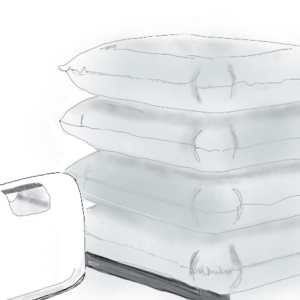This weeks’ blog is by Fiona Cowdell, Professor of Nursing and Health Research (fiona.cowdell@bcu.ac.uk) and Judith Dyson, Professor of Implementation Science (judith.dyson@bcu.ac.uk)
Preventing falls in care homes is policy and practice gold standard. But when falls happen, the protocol for many care homes in the UK is to call an ambulance. Sometimes an older person is waiting for many hours leading to complications1. To address this problem, we evaluated a new initiative, implementation of an app’ to assess “risk to rise” and a lifting cushion. The “ISTUMBLE” app’ seeks key safety information (e.g., pain or bleeding) and based on data inputted concludes safe to rise or otherwise. If safe to rise, the cushion device (see image) is placed under a person and inflated slowly. This initiative took place in 18 care homes in the West Midlands in 2022 and 2023. The purpose was to improve quality of care; assisting a resident to rise when safe to do so, rather than a long uncomfortable time on the floor waiting for an ambulance. Two staff from each home attended an educational workshop and were tasked with training others in the home. When everyone was trained, the cushion was delivered for use.
As nurses and researchers with an interest in getting evidence into practice, we suspected training alone would not be sufficient to support adoption. As well measuring use, we asked carers and nurses about what helped and hindered implementation.
We collected data for 15 weeks before and after adoption of the cushion. Ambulance calls fell slightly in the pre to post adoption period (from 6.9 to 5.6 per week). However, the cushion was only in six out of 18 homes. In total it was used only 32 times out of 567 post-adoption falls.
There were many things that helped and hindered implementation in practice. Staff told us the training was good and the cushion was easy to use, but they were not allowed devices in the workplace and therefore could not use the “risk to rise” assessment app’. So, they did not have the confidence to use the cushion in case they caused greater harm. Some staff did not think the device was suitable for people who were confused, with dementia or had poor upper body strength. Others found it worked well with this group of people so long as they were given time and reassurance, and residents were used to seeing it in use. When those tasked with implementing the device were optimistic and open to trying it adoption was good. Sometimes however, the “implementers” were sceptical and not used to training others. In these cases, the cushion was not used.
Our recommendations for care home staff to improve future adoption included: an electronic device with the app’ kept with the cushion, external training to include use of the cushion with people who are confused, with dementia or poor upper body strength, selecting staff who were positive about the potential of the cushion to attend training and lead implementation, deliver on-site training where the residents could join in to reassure them and familiarise them with the cushion.
Implementation science is a scientific approach to promoting the uptake of research evidence into practice. As healthcare practitioners we tend to make a common mistake. We think that if we “tell” people what to do, in workshops, training or guidelines, they will do it. But it’s not that simple. It can take 17 years to get evidence into practice 2. A different way of promoting the uptake of best practice is to understand the challenges and address them and understand the facilitators and enhance them as we did here 3.
References
- BLACKBURN, J., OUSEY, K., STEPHENSON, J. & LUI, S. 2022. Exploring the impact of experiencing a long lie fall on physical and clinical outcomes in older people requiring an ambulance: A systematic review. International emergency nursing, 62, 101148
- MICHIE, S., JOHNSTON, M., ABRAHAM, C., LAWTON, R., PARKER, D. and WALKER, A., 2005. Making psychological theory useful for implementing evidence-based practice: a consensus approach. BMJ quality & safety, 14(1), pp.26-33.
- MORRIS, Z. S., WOODING, S. & GRANT, J. 2011. The answer is 17 years, what is the question: understanding time lags in translational research. Journal of the Royal Society of Medicine, 104, 510-520.
